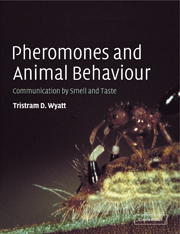Book contents
- Frontmatter
- Contents
- Preface
- Acknowledgements
- 1 Animals in a chemical world
- 2 Discovering pheromones
- 3 Sex pheromones: finding and choosing mates
- 4 Coming together and keeping apart: aggregation and host-marking pheromones
- 5 Scent marking and territorial behaviour
- 6 Pheromones and social organisation
- 7 Pheromones and recruitment communication
- 8 Fight or flight: alarm pheromones
- 9 Perception and action of pheromones: from receptor molecules to brains and behaviour
- 10 Finding the source: pheromones and orientation behaviour
- 11 Breaking the code: illicit signallers and receivers of semiochemical signals
- 12 Using pheromones: applications
- 13 On the scent of human attraction: human pheromones?
- Appendix A1 An introduction to pheromones for non-chemists
- Appendix A2 Isomers and pheromones
- Appendix A3 Further reading on pheromone chemical structure
- References
- List of credits
- Index
2 - Discovering pheromones
Published online by Cambridge University Press: 03 December 2009
- Frontmatter
- Contents
- Preface
- Acknowledgements
- 1 Animals in a chemical world
- 2 Discovering pheromones
- 3 Sex pheromones: finding and choosing mates
- 4 Coming together and keeping apart: aggregation and host-marking pheromones
- 5 Scent marking and territorial behaviour
- 6 Pheromones and social organisation
- 7 Pheromones and recruitment communication
- 8 Fight or flight: alarm pheromones
- 9 Perception and action of pheromones: from receptor molecules to brains and behaviour
- 10 Finding the source: pheromones and orientation behaviour
- 11 Breaking the code: illicit signallers and receivers of semiochemical signals
- 12 Using pheromones: applications
- 13 On the scent of human attraction: human pheromones?
- Appendix A1 An introduction to pheromones for non-chemists
- Appendix A2 Isomers and pheromones
- Appendix A3 Further reading on pheromone chemical structure
- References
- List of credits
- Index
Summary
Introduction
Until recently, our own poor sense of smell and the relative difficulty of studying pheromones has left the subject lagging behind the study of visual and auditory signals. Apart from the behavioural complexities of studying signals of any kind, pheromones present particular problems. First, the chemical messages are complex in many species, especially in mammals and social insects. Second, the small amounts available to the chemist are often at the limit of current analytical techniques. Third, whereas sound signals such as cricket song can be played back from a tape or indeed ‘synthesised’ or manipulated experimentally by computer, ‘playback’ for pheromones is much more difficult given the limits of chemical synthesis and the sensitivity of olfactory receptors to the precise nature of the pheromones.
It is difficult to imagine now, when the role of pheromones in behaviour is so well established, that not so long ago it was hard to show that chemicals were involved, let alone identify the compounds. In the nineteenth century, the French naturalist Jean-Henri Fabré found that a virgin female emperor moth (Saturnia pavonia) could attract dozens of males into his study. The males were still attracted to a female hidden under a cover so long as it was not airtight. These observations convinced him that the attraction must be chemical even though he could not smell anything (Fabré 1911, p.137). We know now that humans cannot smell most of the chemicals important to other animals.
- Type
- Chapter
- Information
- Pheromones and Animal BehaviourCommunication by Smell and Taste, pp. 23 - 36Publisher: Cambridge University PressPrint publication year: 2003
- 1
- Cited by



